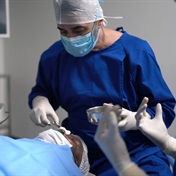Researchers at the University of Tokyo's School of Medicine have shown for the first time that caffeine intake can significantly increase the eye's ability to produce tears, a finding that could improve treatment of dry eye syndrome.
This common eye condition affects about four million people age 50 and older in the United States. For many, dry eye syndrome is simply uncomfortable and annoying, but for others it escalates into a vision-threatening disease.
All of the 78 participants in the new study produced significantly more tears after consuming caffeine than after taking a placebo. The study is available in Ophthalmology, the Journal of the American Academy of Ophthalmology.
Dry eye syndrome involves malfunction of the rate of tear production, the quality of tears, and/or the rate of evaporate from the surface of the eye. Anyone can experience dry eye, though it is more common among women. Symptoms can include gritty, scratchy or burning sensations, excessive tearing, and/or production of stringy mucus.
The research team, by Reiko Arita, MD, PhD, was motivated by an earlier study that had shown a reduced risk for dry eye in caffeine users: 13% of users had the syndrome compared with nearly 17% of non-users.
What caffeine does
The team knew that caffeine was likely to stimulate tear glands, since it is known to increase other secretions, such as saliva and digestive juices. They also knew that people respond differently to caffeine, so they analysed study participants' DNA samples for two genetic variations that play important roles in caffeine metabolism. Tear production proved to be higher in study subjects who had the two genetic variations.
"If confirmed by other studies, our findings on caffeine should be useful in treating dry eye syndrome," said Dr Arita. "At this point, though, we would advise using it selectively for patients who are most sensitive to caffeine's stimulating effects."
The study subjects were divided into two groups: one received caffeine tablets in the first session and a placebo in the second session, while the order was reversed for the other group. Tear volume was measured within 45 minutes of consuming the tablets.
What can you do with dry eyes?
All sessions took place between 10 am and noon, a time of day when tear production is usually stable. No subjects knew whether they received caffeine or the placebo. All abstained from caffeine use for six days prior to each session and used no drugs during the sessions.
To be eligible for the study subjects had to be free of high blood pressure, dry eye syndrome, allergies that affect the eye, glaucoma, and other eye diseases and conditions that can interfere with tear production. The study also found that tear drainage rates were not affected by caffeine.
Dry eye can be very uncomfortable and interfere with vision. It's important to see an ophthalmologist if symptoms continue, since advanced cases can cause eye damage and permanent vision problems. Current treatment options range from simple warm compresses, eye washes and artificial tears to medications and tear drainage devices.
(EurekAlert, April 2012)
Read more:




 Publications
Publications
 Partners
Partners










